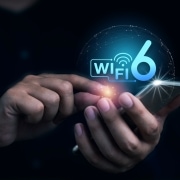Wi-Fi 6 and 5G: The Future of Wireless Connectivity is Here.
Last Updated on April 20, 2022
As corporate networks continue to grow and expand, Wi-Fi 6 technology has become essential for ensuring reliable and efficient connectivity. Without robust wireless technologies, corporate networks would be unable to keep pace with the ever-increasing demand for data and content sharing.
As devices increasingly adopt Wi-Fi 6 technology, enterprises will need to adapt their infrastructures to meet demand. This trend is expected to continue in the coming years, as Wi-Fi 6 devices outpace 5G devices in adoption and usage.
Table of Contents
Wi-Fi 6 adoption
Some 2.5 billion Wi-Fi 6 devices are projected to be sold worldwide this year, compared to 1.5 billion 5G devices. Smartphones, tablets, and PCs are among the most popular devices equipped with Wi-Fi 6. However, it is in many other devices, including wireless cameras, smart home devices, and games consoles.
Better Performance
The new Wi-Fi 6 standard offers improved performance and efficiency over previous generations of Wi-Fi by making more efficient use of available radio resources and serving multiple devices simultaneously. The new standard can provide up to four times the performance of older networks, drain less battery power from connected devices, and reduce latency for near real-time use.
Faster
One of the benefits of sixth-generation Wi-Fi technology is that it improves coverage and increases data transmission speeds. The theoretical maximum speed of sixth-generation Wi-Fi is approaching 10 Gbit/s, which significantly increases the previous generation's theoretical top speed of 7 Gbit/s.
Home to Stadiums
The new wireless standard was designed with households in mind. Still, with the advent of the Internet of Things (IoT), it is primarily used for business purposes, such as automated factory floors and the logistics industry. Moreover, as it can accommodate many users simultaneously, it is perfect for public venues such as stadiums and airports.
A great companion to 5G
With the recent surge in 5G development, it may seem that 5G will be the primary focus of future wireless networks in enterprises, with Wi-Fi 6 playing a minor role at best. However, both technologies will be critical in the coming years as enterprises strive to provide faster, more reliable connectivity for their employees and customers.
It should come as no surprise that Wi-Fi 6 and 5G have similar capabilities, as they both offer complementary strengths. Both technologies enable faster speeds, lower latency, and more devices to be connected at once. The main differences lie in range, mobility support, and cost.
Future Interoperability
The next generation of wireless networks, Wi-Fi 6 and 5G, are designed to work together seamlessly. The wireless industry is moving towards a future where devices can roam securely and seamlessly between wireless networks. This would allow for increased connectivity and could potentially revolutionize how we use wireless devices.
Industry associations and standardization bodies are working together to develop new network standards that enable the convergence of cellular and non-cellular technologies, thus integrating Wi-Fi 6 into 5G core networks. The benefits of integrated systems include more efficient traffic management in factories and continuous service delivery for smart city and edge applications.
5G and Wi-Fi 6 are cutting-edge technologies that offer speedy connections with low latency. Wi-Fi 6 deployments are ahead of 5G in some areas because Wi-Fi 6 is an evolutionary upgrade to the existing Wi-Fi standard, while 5G is an entirely new technology. In addition, Wi-Fi 6 offers backward compatibility with older devices, while 5G does not.
Deployment Cost
And there is the cost of Wi-Fi 6 devices, which are more affordable and more widely available than 5G devices. In many countries, businesses need to obtain a license from a network operator or government agency to access the 5G radio spectrum. While Wi-Fi 6 uses a free, unlicensed spectrum.
One of the other benefits of this technology is its ease of deployment. By upgrading to Wi-Fi 6 networks, companies can reap the benefits of compatibility with previous versions.
Replacing older Wi-Fi devices all at once can be costly, but gradually upgrading access points as needed is much more cost-efficient. In addition, many IT departments already have expertise in installing and operating Wi-Fi networks, which means that they are well-positioned to take advantage of Wi-Fi's benefits.
Constructing a 5G network requires acquiring new skills and understanding more complex concepts, as the standard differs significantly from previous generations.






Leave a Reply
Want to join the discussion?Feel free to contribute!